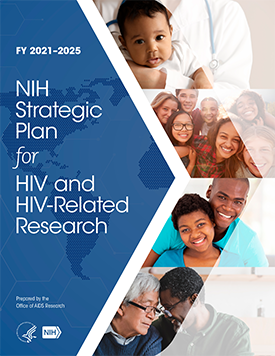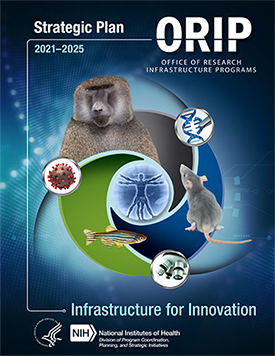Reducing the Incidence of HIV: The Role of NIH Infrastructure
Each year, on May 18th, we join together to observe HIV Vaccine Awareness Day (HVAD), led by the National Institutes of Health (NIH) National Institute of Allergy and Infectious Diseases (NIAID). This day provides an opportunity to focus on the importance of HIV vaccine research and to thank community members, clinical study participants, health professionals, and scientists for working together to pursue a safe and effective HIV vaccine.
Since the first description of AIDS almost 40-years ago, there has been significant progress in preventing infection with the causative agent, human immunodeficiency virus, HIV. Scientific advances have produced a robust HIV prevention toolkit to reduce the risk of infection; however, HIV remains a serious public health challenge in the United States and globally.
In the United States and six dependent areas: From 2014 to 2018, the annual number of new HIV diagnoses decreased by 7%. As of 2018, an estimated 1.2 million people had HIV, although about 1 in 7 was unaware of having HIV. That year, close to 38,000 individuals received a new HIV diagnosis: adult and adolescent Blacks/African Americans accounted for 42%, and Hispanic/Latinos accounted for 27%. Gay, bisexual, and men who have sex with men accounted for 69% of all new HIV diagnoses, while heterosexuals accounted for 24%.¹
As part of its mission, the Office of AIDS Research (OAR) establishes HIV/AIDS research priorities for NIH to ensure that funding is directed to the highest priority research areas and facilitates maximal return on investment. The development of safe and effective vaccines against HIV remains a top priority for the NIH. An effective vaccine will save countless lives and is necessary to achieve a durable end to the HIV/AIDS pandemic.
OAR works in partnership with the NIH Office of Research Infrastructure Programs (ORIP) to ensure that essential infrastructure is in place to support NIH vaccine research. Both OAR and ORIP are located within the Division of Program Coordination, Planning, and Strategic Initiatives in the NIH Office of the Director (OD). ORIP advances the NIH mission by supporting research infrastructure and research-related resource programs.
To commemorate HIV Vaccine Awareness Day, I invited my colleague, Dr. Franziska Grieder, the ORIP Director, to discuss the status of NIH HIV vaccine research infrastructure. Here are some highlights from that discussion.
Dr. Goodenow: Non-human primates (NHP) are a critical resource for the development of a vaccine against HIV. Could you talk about the collaborative OAR and ORIP efforts to advance NHP research models and improve facilities?
Dr. Franziska Grieder: For almost a decade, OAR and ORIP have closely engaged in enhancing NHP colonies in support of groundbreaking HIV/AIDS research. Given their similarities to humans, NHPs are essential for translational HIV/AIDS research, including investigations of viral reservoirs, therapeutic and vaccine development, and research toward a cure.
ORIP collaborates with OAR to support NHP breeding colonies, facilities, and other research resources to facilitate effective use of NHPs for NIH-funded HIV/AIDS research. These programs primarily include the seven National Primate Research Centers (NPRCs), the Caribbean Primate Research Center, and ten specific pathogen-free (SPF) macaque colonies. The centers and colonies co-funded by OAR and ORIP have devoted sustained support of HIV/AIDS research by providing the NHP models, composed of SPF rhesus or pigtail macaque monkeys, as well as the facilities and expertise needed for this area of research across NIH Institutes, Centers, and Offices.
ORIP also partners with OAR to provide specialized antibodies and other reagents needed for HIV/AIDS studies of disease progression, coinfections, host defense mechanisms, and the design, development, and testing of vaccines.
OAR and ORIP have also worked together to support improvements of the physical infrastructure for HIV/AIDS research with an emphasis on NHP research facilities, including animal housing and dedicated research space. In the last two years, we have funded six facilities to expand space for animal colonies and research activities. Additional administrative supplements for alteration and renovation projects have given our offices many opportunities to quickly respond to emerging and pressing needs.
Dr. Goodenow: What is so special about SPF macaques, and how do the SPF macaque breeding colonies fit into OAR’s and ORIP’s efforts to support HIV/AIDS research?
Dr. Franziska Grieder: The presence of certain viral pathogens in NHPs can obscure the results of HIV/AIDS investigations or pose a health risk to staff. Consequently, a consortium of rhesus and pigtail macaque colonies was developed to ensure a supply of SPF macaques for HIV/AIDS research that are free of these confounding or risky viruses. Beyond the basic set of four excluded viruses that define “SPF macaques,” four additional viral agents are excluded from expanded SPF (eSPF) colonies. Keeping the NHPs free of these additional pathogens allows certain viruses to be used in the process of vaccine development, and it also enables investigators to study how opportunistic infections result from immune deficiency.
Colonies in the SPF Macaque Breeding Colony Consortium were originally derived through a careful test-and-exclude strategy applied to the founding animals. Since then, the colonies have remained closed, with colony growth arising from within-colony breeding. Maintenance of the colonies includes genetic testing and pedigree tracking to ensure genetic diversity, which is important for the health of the SPF colonies. The SPF macaques are also characterized in terms of immune system genes that affect how the monkey equivalent of AIDS progresses in these animals, and this genetic information is provided to investigators to improve the reproducibility of their work.
The SPF Macaque Breeding Colony Consortium supports more than 7,000 SPF rhesus macaques that are maintained at six institutions across the United States, with an additional 800 eSPF rhesus macaques maintained at three of those institutions. More than 800 SPF pigtail macaques are maintained at two other institutions. Consortium-wide, upwards of 100 different HIV/AIDS research projects are supported with macaques from these SPF colonies each year, most of which are NIH-funded projects.
Dr. Goodenow: When natural disasters impact infrastructure for HIV/AIDS-related research, OAR and ORIP have worked together to implement renovations to ensure that scientific discovery continues. An excellent example of this is the rebuilding and renovation of the HIV/AIDS Non-Human Primates Research Facility that followed Hurricane Maria. Could you share some details on how that investment and rebuild evolved through our partnership?
Dr. Franziska Grieder: Hurricane Maria, a deadly Category 5 hurricane, devastated parts of Puerto Rico on September 19-21, 2017, and impacted NHP resources jointly supported by ORIP and OAR that sustain HIV/AIDS-related research.
A collaborative OAR-ORIP effort resulted in publication of PAR-18-693: Limited Competition: HIV/AIDS-related Non-Human Primate Animal Research Facilities Restoration Program in the Aftermath of Hurricane Maria. This funding opportunity announcement sought applications from qualified academic institutions in Puerto Rico whose NHP facilities were impacted by this natural disaster and were seeking to recover, restore, and modernize damaged physical infrastructure to continue supporting NIH-funded HIV/AIDS research.
Two construction grants totaling $7.8M were awarded in 2018 to the University of Puerto Rico for the restoration of NHP housing and related research facilities associated with the Caribbean Primate Research Center. Both projects are expected to be completed by 2023, as proposed in the applications.
Dr. Goodenow: Are there other ways that OAR can support ORIP to develop and improve the physical and intellectual infrastructure for HIV research?
Dr. Franziska Grieder: Our offices have partnered on many infrastructure projects that focus on HIV/AIDS research. For example, we collaborated to develop a funding opportunity announcement to fund a research facility that supports the development of the next generation of HIV/AIDS vaccine candidates. This facility had to meet Current Good Manufacturing Practice standards to enable the production of pharmaceuticals for small clinical trials. The successful competition resulted in an award in 2017.
ORIP and OAR share other common goals in addition to physical infrastructure and NHP colonies. One example of our shared vision is support for the training of young scientists engaged in biomedical research. To promote the sustainability of HIV/AIDS research, ORIP and OAR have worked together to support the next generation of HIV/AIDS investigators through training grants for pre- and post-doctoral trainees, career development awards for early-stage investigators (ESIs), and research grants for ESIs. In particular, the HIV/AIDS Scholars program includes key components to ensure that ESIs successfully transition to independent research. Activities include research support, access to an expanded mentoring team with expertise in both NHP and clinical translational research, plus support from a dedicated NHP facility. The program also provides funding for a conference specifically for the ESIs to promote networking, address scientific goals, and afford practical career advice. A second conference with established investigators at the leading edge of NHP research on HIV/AIDS is an important commitment for more in depth interactions.
These are just a few examples from nearly ten years of shared vision and joint efforts by OAR and ORIP in support of brick and mortar infrastructure projects as well as workforce and research resource activities. Our offices will continue working together to ensure that today’s investigators and tomorrow’s rising talents have access to the training opportunities, infrastructure, NHPs, and other resources needed to address NIH’s research priorities and sustain future progress to fight HIV/AIDS.
Dr. Goodenow: Thank you, Franziska. This conversation has been very informative. The OAR is committed to continued collaborations with ORIP to improve health outcomes for all people who are at risk for HIV.
As noted in my Director’s Blog on HIV Prevention Forward, large HIV vaccine studies are underway, such as Mosaico and PrEPVacc, as are smaller preliminary studies assessing promising approaches. For example, a first-in-human clinical trial recently reported the feasibility of a novel HIV vaccine approach.
To learn more about HIV vaccine research, I encourage readers to visit the NIAID HIV Vaccine Development webpage and the HIV Prevention Trials Network.
Maureen M. Goodenow, Ph.D.
NIH Associate Director for AIDS Research and
Director, NIH Office of AIDS Research
Franziska B. Grieder, D.V.M., Ph.D.
Director, Office of Research Infrastructure Programs, OD, NIH
¹ https://web.archive.org/web/20240422002453/https://www.cdc.gov/hiv/basics/statistics.html
This page last reviewed on December 10, 2024



